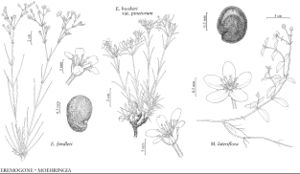Moehringia
Sp. Pl. 1: 359. 1753.
Gen. Pl. ed. 5, 170. 1754.
| Taxon | Illustrator ⠉ | |
|---|---|---|
 | Eremogone fendleri Eremogone hookeri var. pinetorum Moehringia lateriflora | Barbara Alongi Barbara Alongi Barbara Alongi |
Herbs, annual or perennial. Taproots slender, rhizomes slender or absent. Stems prostrate or ascending to erect, simple or branched, terete or angled. Leaves not connate, petiolate or sessile, not congested at or near base of flowering-stem; blade 1–3 (–7) -veined, lanceolate to elliptic or ovate to broadly ovate, not succulent, apex acute or obtuse. Inflorescences terminal or axillary, open cymes, or flowers solitary; bracts paired and foliaceous, or smaller and mostly scarious. Pedicels erect or recurved in fruit. Flowers: perianth and androecium weakly perigynous; hypanthium minute, disc-shaped; sepals (4–) 5, distinct, green, ovate to obovate, 1.7–6 mm, herbaceous, margins white, scarious, apex obtuse or acute to acuminate, not hooded; petals (4–) 5, white, not clawed, blade apex entire; nectaries as fleshy lobes at base of filaments opposite sepals, ca. 3 times width of filament, connate proximally into basal disc; stamens 10, occasionally 8, arising from nectariferous disc; filaments distinct; staminodes absent; styles 3, filiform, 1.5–1.8 mm, glabrous proximally; stigmas 3, linear along adaxial surface of styles, minutely papillate (30×). Capsules broadly ovoid to subglobose, opening by 6 revolute teeth; carpophore absent. Seeds 2–6, reddish-brown to blackish, ellipsoid to reniform, laterally compressed, shiny, smooth to minutely tuberculate, marginal wing absent, appendage white, ± elliptic, spongy. x = 12.
Distribution
North-temperate North America, Europe, Asia
Discussion
Species 25 (3 in the flora).
Members of Moehringia and Petrocoptis (a segregate from Silene, comprising four species in the Pyrenees) are the only Caryophyllaceae with strophioles (eliasomes), spongy seed appendages that attract ants. Foraging ants gather the seeds, eat only the strophiole, and “plant” the seeds in their nests.
We follow J. McNeill (1962) and V. Bittrich (1993) among others in recognizing Moehringia. The appendaged (strophiolate) seed and a chromosome base number of 12 are the chief characters distinguishing Moehringia from Arenaria. Although McNeill noted that this distinction is similar to features used to distinguish subgenera within Arenaria, he retained Moehringia and suggested that, among other evidence, cytological investigation of the North American species of Moehringia and members of Arenaria subg. Leiosperma McNeill (New World, especially Andean South America) would help support such action. Chromosome counts made since 1962 do show x = 12 in North American Moehringia and x = (10) 11 for Arenaria subg. Leiosperma.
Selected References
None.
Key
| 1 | Plants annual (or short-lived perennial?); stems prostrate or ascending, pubsecence in 2 lines; leaves petiolate, petioles 1-4 mm, blade ovate to broadly ovate | Moehringia trinervia |
| 1 | Plants perennial, with extensive rhizome systems; stems prostrate or ascending to erect, pubescence ± uniform; leaves sessile or subsessile, petioles 0.1-1 mm, blade mostly lanceolate to elliptic | > 2 |
| 2 | Stem pubsecence retrorse; sepals (herbaceous portion) oblong to elliptic, apex mostly rounded or obtuse, 1.7-2.8(-3) mm; petals ca. 2 times as long as sepals | Moehringia lateriflora |
| 2 | Stem pubescence peglike, spreading; sepals (herbaceous portion) lanceolate, apex acute to acuminate, (2.8-)3-6 mm; petals 4-1 2 times as long as sepals | Moehringia macrophylla |